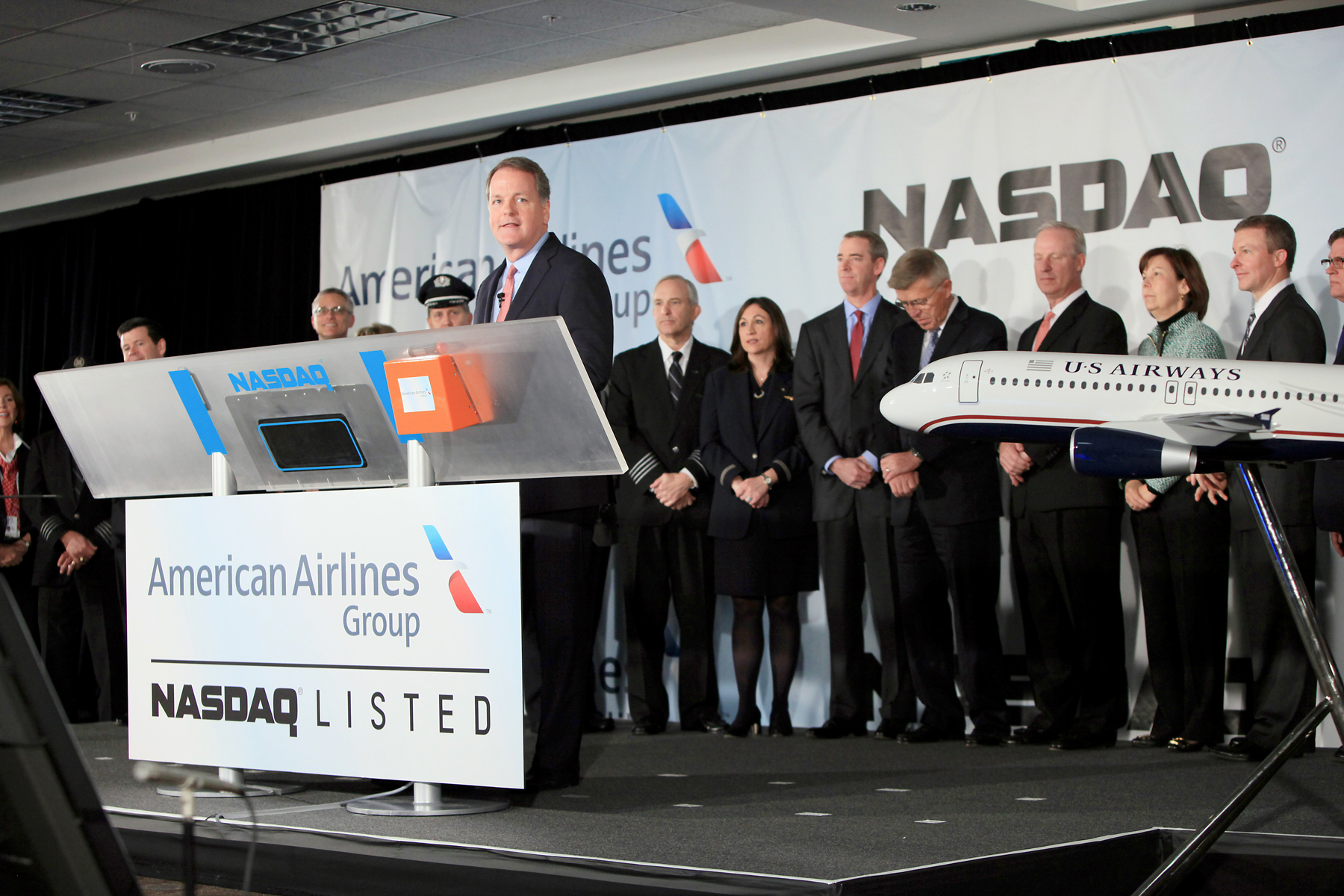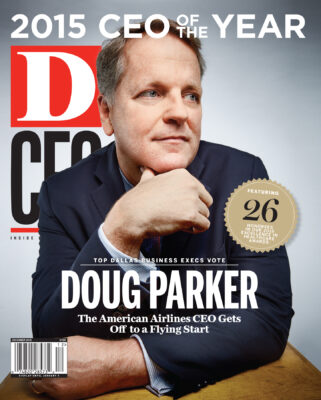American Airlines group’s origins reportedly date to a 1930s merger of more than 80 small carriers. In the time since, it’s doubtful a CEO of the company has ever been charged with more important work than what Doug Parker has overseen this year.
American’s latest incarnation, formed in December 2013, generated $42.6 billion in sales last year, making it the world’s largest airline company by revenue, according to Forbes. The business was formed by what Bloomberg has tabulated as the $17 billion merger of the old AMR Corp. and the Tempe, Ariz.-based carrier Parker previously ran, US Airways. The new American now carries an average of more than 500,000 passengers each day on about 6,700 flights, hitting 330 destinations in 54 countries.

It is a staggering task—one that Parker volunteers will never win the carrier any fans, no matter how well it goes. “If you do it right, no one knows you did it right,” he says. “When you don’t do it right, you hear about it.”
•••
The fact that the outside world has noticed so little about the integration work is one reason Parker’s C-suite peers named him Dallas-Fort Worth’s 2015 CEO of the Year in the CEO Sentiment Survey, conducted annually by SMU’s Cox School of Business. (In addition, D CEO has honored five other outstanding chief executives; see their stories on page 50.)
On the weekend of Oct. 17, for example, American moved US Airways onto its reservations system. Some 23 months in the making, the reservations crossover went off with what published accounts said were only minor, temporary issues.
“The integration of reservations systems is the single toughest component of operations to integrate smoothly, and it appears to have gone well for American,” says Michael Lum, Dallas-based executive director of air service strategy and development at Sixel Consulting Group. By contrast, The Wall Street Journal noted, when United Continental Holdings tried the same trick in 2012, the ensuing problems “disrupted passengers and employees alike for weeks.”
Other successful integration steps Parker’s crew pulled off this year include the March shift of US Airways’ frequent-flier program onto American’s. American also opened an $88 million, 149,000-square-foot communications center in Fort Worth for handling operations-related jobs like flight dispatch, crew scheduling, and air traffic control. And in late October, the company announced plans to build a new four-building corporate headquarters on 300 acres it had leased near the communications center, squelching rumors that American was considering moving its home base out of Fort Worth.
Yet despite his successes in combining the operations of two big companies, Parker knows the end game lies ahead. That is turning the merged business of US Airways and AMR into Parker’s stated objective of being the best—and most profitable—air carrier on Earth. “I’m excited about what American can be,” he says. “We’re not there yet. We’re in the middle of restoring this fantastic airline. The potential is all there, and we’re beginning to see the fruits of all this work.”
•••
Airlines have historically seen business disruptions caused by everything from deregulation and oil price shocks to terrorism, health pandemics, global financial crises, and competition from carriers with new business models. As a result, few industries have as many areas where big mergers can go awry as the friendly skies.
“Probably the largest [potential pitfall] is creating a corporate culture that overcomes distrust and works to create a team spirit, a sense of ‘we’ instead of ‘us’ and ‘them,’” says James Simmons, a professor of aviation and aerospace science at Metropolitan State University of Denver.
Ideally, airlines should “pre-resolve” cultural and labor issues before the integration process, according to Robert Mann Jr., president of R.W. Mann & Co. Inc., an analysis and consulting firm specializing in the air carrier industry. However, Mann notes, the solutions that airlines implement to workforce-related questions are “subject to fraying.”
Another saber-toothed tiger to tame in mergers is systems integration, the job of getting different technology systems to talk to each other and play well in the same sandbox. Reservations systems fall into this category, as do software and computing technology for handling crew planning, maintenance, airport check-in, and departure.
“It’s a diverse system spread over the entire world, in the case of American,” says R. John Hansman Jr., a professor of aeronautics and astronautics and engineering systems at the Massachusetts Institute of Technology. “An airline runs 24/7, so it’s not like they can shut down for one day” to do the integration.
Within an airline’s information technology system, one element in particular can be especially problematic in merger integrations, experts say. “The component that leaves the most room for disaster if it goes wrong is the combining of the airlines’ operations systems,” contends Martin Rottler, a lecturer at The Ohio State University Center for Aviation Studies.“The potential is all there, and we’re beginning to see the fruits of all this work.”
Doug Parker
Aside from reservations, operations systems include a host of other functions, such as taking care of frequent-flier information, baggage tracking, aircraft and crew scheduling, as well as flight planning and scheduling, Rottler notes.
Operations systems can be run under a one-umbrella technology approach, or through a patchwork of systems that must interact with one another both on the customer-facing side and the employee-facing end, Rottler says.
“Compounding this potential complication is the fact that the skeletons of these computer systems date back to infrastructure that was first created in the 1960s,” he adds. “One miscue or crash [in the technology], and the airlines’ passengers face mounting delays for a day or more.”
Parker knows first-hand about the issues that systems integration can cause. He was at the helm of US Airways 10 years ago when, in merging with America West, technology-related snafus caused headaches. He learned a lot, he says.
“As much as anything, we learned to get our full team engaged,” Parker says. “There is a tendency to treat big projects like this as ‘systems projects’ because they are, but if you do that you can lose sight of the people aspect of the project. In US/AWA, we cut over without fully appreciating all of changes the new system imposed on our people. This time, we had the systems team work as one with our operations team from the beginning and at every step along the way. As a result of that engagement, our people were prepared.”
Parker’s US Airways tenure also gave him experience in the bugaboos inherent in merging seniority lists for unionized employees like pilots. These lists can dictate everything from the type of equipment that gets used on given flights to who gets furloughed when the economy goes south. Even today, there are two separate seniority lists for pilots of what was US Airways, owing to longstanding and unresolved litigation between unions representing pilots for that airline and the old America West, says Bijan Vasigh, professor at the Daytona, Fla., campus of Embry-Riddle Aeronautical University.
Pilots’ unions weren’t the only labor groups bickering at Parker’s old stomping grounds. Even after the two airlines had been integrated, America West flight attendants felt that their US Airways counterparts had better work-rule protections, Vasigh says.
The squabbles over seniority lists at US Airways have carried over to the new American, he adds. The standoff between the America West and US Airways pilots’ associations means American now has three pilots unions. “Integrating them as efficiently and quickly as possible is a key to success,” Vasigh says.
•••
One important lesson from airline mergers is to maintain good relations with labor groups, experts say. A strategy for doing this is sharing with the workforce and industry partners the upside that a merger can create, says Robert Kokonis of AirTrav Inc., a Toronto-based aviation advisory.
In January, American employees picketed at the company’s headquarters for work-related improvements such as higher wages after the company announced a record annual profit for 2014 of $4.2 billion (before charges). Parker indicated the company is moving to share the wealth with staffers. Pilots, for instance, are getting “significant pay increases,” he says.
At the same time, American, along with other big carriers, will need to start finding new pilots to cope with a wave of coming retirements experts say will peak in the next 10 years. In this regard, though, American is making headway. According to a company spokesman, the airline has added 1,000 pilots in the past year, over and above attrition from retirements and other departures.
New competition on international routes, which for years have been a significant source of profit, is another challenge taking shape for Parker. On one hand, the long-haul and international realm is seeing low-cost airlines coming out of the woodwork, notably Norwegian Air Shuttle and Iceland’s WOW Air, according to Kokonis at AirTrav Inc. On the other, he says, well-funded airlines like Emirates, Etihad, and Qatar Airways have emerged in the Gulf countries seeking a piece of premium long-distance travel.
In a July 2015 Dallas Morning News column he co-wrote with the heads of the unions for American’s flight attendants and pilots, Parker said his carrier will “compete with any airline—no matter how successful or well-run.”
But, the column asserted, the governments of Qatar and the United Arab Emirates have provided more than $42 billion in assistance to the three Gulf carriers. “If this subsidized expansion continues, U.S. carriers will be forced off more international routes,” Parker and the union heads wrote.
Meanwhile, American, like all airlines, is facing a shift in its customer base. “Airline passengers demand more, but want to pay less,” says Eric Mahler, the North Texas-based managing partner and CEO at Fulcrum Consulting. “The competitive dynamics in the industry are such that, on the whole, airlines have no choice but to comply.”
Parker notes that American has been making a number of improvements to its offerings, such as enhancements to its Admirals Club airport lounges. The carrier has added new furniture, improved food, and added power in those premium locations. “We’ve made a huge investment in our product,” he says, adding: “We’re going to have a record year in 2016.”






